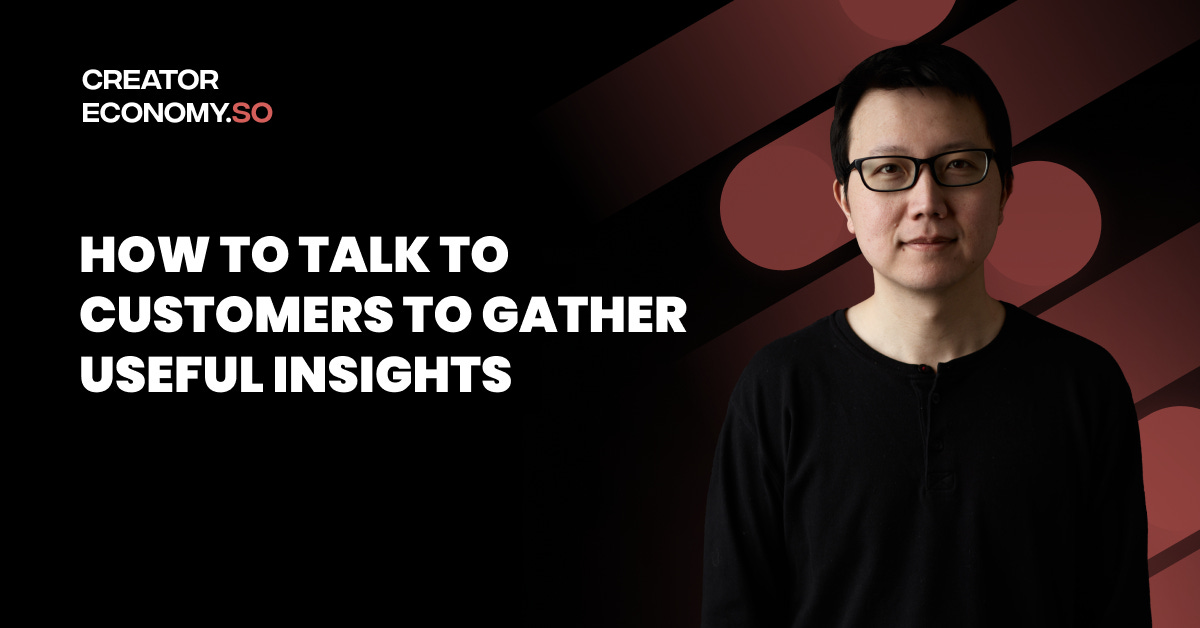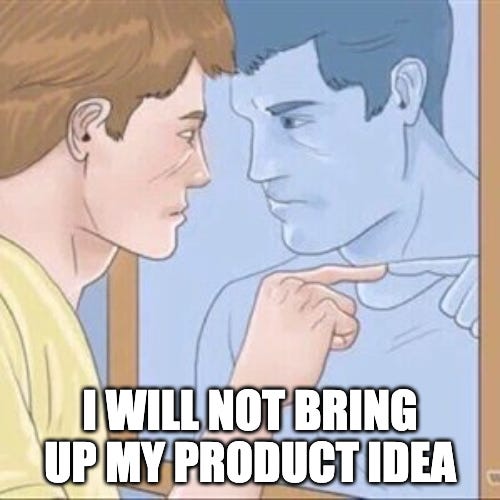How to Talk to Customers to Gather Useful Insights
Talk to customers about their problems, not about your product
Level up your product and creator skills in just 5 min a week. Join 50,000+ readers:
Dear subscribers,
Today, I want to share a practical guide on how to talk to customers.
The only thing worse than not talking to customers is to draw the wrong conclusions. Unfortunately, when founders and PMs talk to me as a potential customer, they too often focus on:
Pitching their product
Asking for feature ideas
Talking more than listening
These are fatal mistakes to make in customer conversations.
Here’s a 5-step guide on how to talk to customers based on my personal experience and Rob Fitzpatrick’s The Mom Test, my favorite book on this topic.
1. Talk to customers about their problems, not about your product
The #1 mistake that people make when talking to customers is to jump straight to talking about their product. Remember:
Customers know their problems, not how to solve them.
As Rob Fitzpatrick wrote in his book, “Ask questions that even your mom can’t lie to you about. When you do it right, they won’t even know that you have a [product] idea.”
Talk to customers to uncover problems and then talk to your team to create solutions. Don’t get these two steps mixed up.
2. Ask customers about their past experiences
To uncover problems, ask customers to describe a past experience.
Customers know their past struggles, not what they want in the future.
Here are five great questions to ask about the past:
Walk me through the last time you had this (experience).
Understand what the customer was thinking, feeling, and doing.What’s the hardest thing about this experience?
Understand what the customer thinks their problem is.How often do you experience this problem?
Understand how frequently this problem occurs.Why was it hard?
Understand if there’s a deeper problem than what was shared in question #2.What solutions have you explored to address this problem?
Understand if customers are motivated to solve their problem.
Focus the interview on past experiences instead of future opinions to uncover the underlying problem.
3. Listen and follow up
The best way to conduct a customer interview is to ask good follow-up questions to get the customer to talk more.
Customers won’t tell you everything right away, so you have to dig for insights.
Here are three ways to dig:
Mirror: Repeat key words that the customer said
This will prompt customers to share more information with you.
Customer: “I just want one place to manage my personal website and blog.”
Interviewer: “Just one place?”
Customer: “Yes, it really sucks when I have to use separate platforms to…”
Labels: Use phrases like “It sounds like…”
This will tease out the customer’s emotion and underlying problem.
Customer: “I spend 10 hours every week dealing with invoices. It’s insane!”
Interviewer: “It sounds like you’re really frustrated by this.”
Customer: “Yes, the problem is when my international customers want receipts…”
Follow up: Ask “Why” until you uncover the problem
Follow up using questions like “Why is this important?” and “Can you tell me more?”
Customer: “I want to create a personal website to drive my social followers to.”
Interviewer: “Why is this important to you?”
Customer: “Well I want to get more emails so that I have a direct channel to my audience.”
4. Deflect compliments, fluff, and ideas
Despite your best efforts…
Customers might give you false positives like compliments, fluff, and ideas.
There’s an entire chapter in the Mom Test dedicated to how you can bring these conversation back on track:
Compliment: “I really love that idea!”
Compliments happen when you mention your idea. Bring the conversation back to the customer problem:
Interviewer: “What if you could achieve inbox zero in just 5 minutes everyday?”
Customer: “I love that idea! How would that work?”
Interviewer: “Sorry I didn’t mean to jump ahead. How do you deal with email right now?”
Fluff: “I would definitely want that!”
Fluff happens when you ask hypothetical questions (e.g., “Would you ever…”). Bring the conversation back to past specifics:
Interviewer: “Would you ever want a better way to find local events?”
Customer: ”Yes, I would definitely want that!”
Interviewer: ”Can you walk me through the last time you tried to find a local event?”
Idea: “You should build feature X!”
Ideas are fun for customers to brainstorm. When this happens, probe deeper to understand what their underlying problem is. A cheeky example:
Customer: “You should give me faster horses!”
Interviewer: “Why do you want that?”
Customer: “It takes way too long for me to get to town everyday.”
5. Get commitment
Conducting an interview is just the first step.
Customers that truly care about their problem are motivated to help you solve it.
I’ve written in the past about the importance of tight customer feedback loops. Instead of relying on a one-off interview, you’re should ideally be talking to customers everyday to build a relationship.
So if your customer discovery call is going well, close by asking the customer to make a commitment with their time, reputation, or money:
Time: “Would you like to join my community or do another call later?”
Reputation: “Can you refer me to another potential customer?”
Money: “Would you like to pre-pay for the product?”
The stronger the commitment, the more likely they are to be an actual customer.
To recap, here’s how you can talk to customers to gather useful insights:
Talk to customers about their problems, not about your product
Ask customers about their past experiences
Listen and follow up
Deflect compliments, fluff, and ideas
Get commitment
Now go out and have some better customer conversations 😉
Subscribe below to level up your product and creator skills in just 5 min a week:
If you enjoyed this post, consider taking a moment to:
Refer a friend to unlock my 180+ page PM book and paid subscriptions for free.
Sponsor this newsletter to reach 50,000+ tech professionals and creators.








Wow, thanks for this ultra-qualitative article !
Exactly what I have been looking for, Thanks!